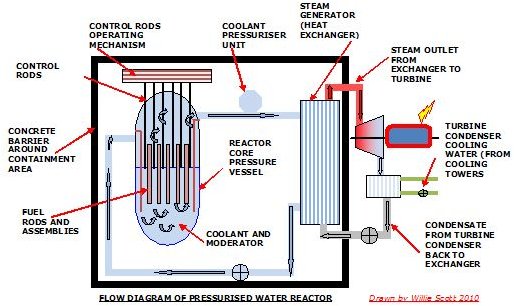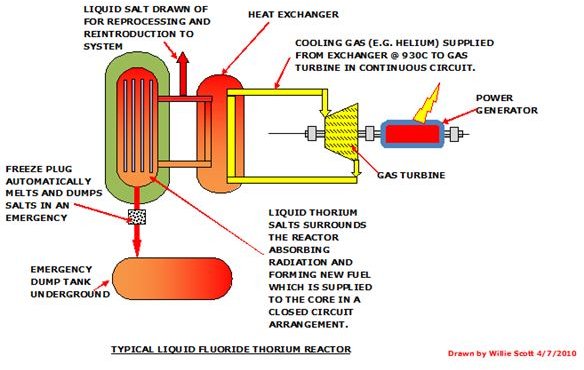Uranium and Thorium Nuclear Power Plants - A Comparative Study
Uranium and Thorium Nuclear Power
Nuclear power has been producing thermal energy since the mid-fifties, when the first Russian nuclear plant generated power for their national grid.
Since then many types of nuclear reactors have been designed and are operating world-wide.
Enriched uranium is used as thq fuel in reactors, but it has the ever present inherent trait of producing high level waste and actinides in the form of plutonium and curium. These remain at very high temperatures and must be kept under water in ponds, normally at the nuclear plant, for five or six years.
Alternative fuels have been investigated to power nuclear reactors, with Thorium being one of these options.
This is another article on Nuclear Energy, and in particular the use of uranium and thorium as nuclear fuel and subsequent radioactive waste produced. We begin with a look at how the different fuels can be extracted and processed.
The Extraction and Processing of fuels used in Nuclear Power Generation.
Uranium Extraction and Enrichment.
The top three countries mining uranium ore are Kazakhstan, Canada, and Australia in that order.
- Mining the Uranium Ore
There are several methods currently in use to mine uranium ore, traditional open pit and underground mining being the most popular techniques.
Underground mining for uranium ore used to be a very hazardous occupation with many miners suffering from effects of radon gas. Nowadays however, underground workings are well ventilated with large air ducts expelling the radon gas.
The uranium ore contains about 99.25% U238, 0.7% U235, and trace amounts of U234.
The U235 is extracted from the ore through crushing, milling, and leaching in acid; it is further processed to yellow cake that contains many uranium oxides. (U3O8)
The yellow cake is calcined and purified; converting U3O8 into UO3 in the process, then being further processed into 3-4% enriched uranium dioxide (UO2) discs or pellets.
The fuel is now ready to be loaded into fuel cells and installed into the reactor core.
Thorium Extraction
The sodium hydroxide is heated in a vessel to around 140⁰C (284⁰F) for 3 hours which produces a mud-like solution. This is then fed into a dilution vessel where water at 100C is injected to dissolve the valuable sodium phosphates that are later extracted.
Following this, the solution is then filtered to remove mixed hydrous oxides that are heated to 150⁰C, crushed, and nitric acid added forming an aqueous solution.
This is further processed using various screening/filtration techniques from which Thorium Oxide (ThO2) is produced which can now be further processed to nuclear fissile material.
Basically, this is carried out in a fast or thermal reactor where the thorium-232 is irradiated with uranium 233 and absorbs a neutron converting it to thorium–233U; a fertile material which can now be used as a fuel in a thorium nuclear reactor.
Overview of Reactors Operating on Uranium and Thorium Fuels
1. Uranium Reactors
The fuel rods are loaded into the reactor core and the system made operational; here the kinetic energy provided by the fission of the U235 is converted to thermal energy as the neutrons collide with other atoms.
Cooling medium is circulated around the core and pumped through a heat exchanger in a closed circuit. The heat from the cooling medium is used to generate steam which powers steam turbines. The steam turbines drive electric generators, producing power to the national grid.
2 Thorium Reactors
Over the last four or five decades there have been several experimental reactors using thorium-233U, which were mainly successful, demonstrating the possibility of thorium powered nuclear reactors.
However only recently the advantages of using irradiated thorium has been realized and received the intense research and development that it deserves.
There are several design systems for thorium reactors, some using a first stage reactor to irradiate the thorium, and further processing it to Th-233, before using it in a thorium reactor.
Another more recent innovation is to use a seed and blanket system which has a central core of rods surrounded by a blanket.
The central seed core rods contain 20% enriched U-235; these are surrounded by a blanket containing thorium and U-238.
India is now a world leader in the design of thorium for nuclear reactors, its Bhabha Atomic research Centre has designed and is running a 30kW test reactor using U233 and has committed to using thorium to fuel their 300MW Advanced Heavy Water Reactor.(AHWR)
In this particular design, the fuel cells in the core will be assembled using 30 rods of Th-233/ U-233 oxide in the centre surrounded by 24 rods of Th-233/Pu-239 oxide. This will enable the system to be self-sufficient in U-233, with the thorium providing 60% of the nuclear reactors power output, with the design life of the AHWR expected to be 100 years.
Thorium Advanced Heavy water reactors will use the thermal heat generated in the core to produce steam to run steam turbines as per a normal AHWR.
Lastly there has been reactors which use liquid thorium salts, for example the Liquid Fluoride Thorium Reactor which uses a fuel/salt mix of ThF4-U233F4. This is circulated through the core and on to a heat exchanger where a medium such as helium is heated to 1200K (930C) and fed to a gas turbine, returning to the exchanger in a closed loop. The turbine is used to drive an electric generator producing power to the National Grid.
There is a bleed-off in the liquid salt circuit which diverts some of the liquid salt to a processing plant where it is purified and reintroduced to the main salt loop.
There is also an emergency system where if there is an emergency, a freeze plug will melt allowing the liquid salt to enter an underground dump tank.
Advantages and Disadvantages in Using Thorium-233 and Uranium-235 as Nuclear Energy Fuels.
- Advantages of Thorium 233 over Uranium 235
1. Waste products can contain significantly less long-lived radioactive waste than uranium or plutonium.
2. Weapons cannot be proliferated from Thorium.
3. Thorium is more energy efficient, operating at higher temperatures.
4. There are massive supplies of Thorium worldwide.
5. Less environmental damage to the environment through mining, extraction, and processing.
6. Less damaging health effects to workers during extraction.
7. Many valuable metals can be extracted as by-products during the processing of Thorium, as well as medical applications.
8. Thorium does not require enrichment.
- Disadvantages of Thorium 233 over Uranium 235
1. Thorium is non-fissile on its own; it needs a kick-start from Uranium 235, to start a chain reaction, raising the radioactivity of the waste.
2. Although thorium produces much less long lived transuranics; some long life actinides are produced.
3. Research and development of thorium has been slow and underfunded owing to the difficulty to form it into nuclear weapons.
4. It would be difficult to convert existing uranium fuelled plants to thorium use.
Sketches of Typical Uranium and Thorium Nuclear Reactors

Internet Sites Visited
https://ntrs.nasa.gov/archive/nasa/casi.ntrs.nasa.gov/20090029904_2009029422.pdf
https://www.world-nuclear.org/info/inf62.html
https://www.thorium.tv/en/thorium_reactor/thorium_reactor_1.php
